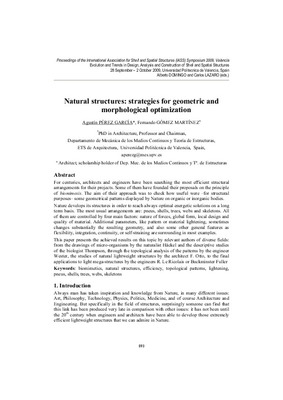JavaScript is disabled for your browser. Some features of this site may not work without it.
Buscar en RiuNet
Listar
Mi cuenta
Estadísticas
Ayuda RiuNet
Admin. UPV
Natural structures: strategies for geometric and morphological optimization
Mostrar el registro sencillo del ítem
Ficheros en el ítem
| dc.contributor.author | Pérez García, Agustín José
|
|
| dc.contributor.author | Gómez Martínez, Fernando
|
|
| dc.contributor.editor | Domingo Cabo, Alberto
|
es_ES |
| dc.contributor.editor | Lázaro Fernández, Carlos Manuel
|
es_ES |
| dc.date.accessioned | 2010-01-26T13:11:18Z | |
| dc.date.available | 2010-01-26T13:11:18Z | |
| dc.date.issued | 2010-01-26T13:11:18Z | |
| dc.identifier.isbn | 978-84-8363-461-5 | |
| dc.identifier.uri | http://hdl.handle.net/10251/6955 | |
| dc.description | p. 893-906 | en_EN |
| dc.description.abstract | For centuries, architects and engineers have been searching the most efficient structural arrangements for their projects. Some of them have founded their proposals on the principle of biomimesis. The aim of their approach was to check how useful were 'for structural purposes' some geometrical patterns displayed by Nature on organic or inorganic bodies. Nature develops its structures in order to reach always optimal energetic solutions on a long term basis. The most usual arrangements are: pneus, shells, trees, webs and skeletons. All of them are controlled by four main factors: nature of forces, global form, local design and quality of material. Additional parameters, like pattern or material lightening, sometimes changes substantially the resulting geometry, and also some other general features as flexibility, integration, continuity, or self-straining are surrounding in most examples. This paper presents the achieved results on this topic by relevant authors of diverse fields: from the drawings of micro-organisms by the naturalist Häckel and the descriptive studies of the biologist Thompson, through the topological analysis of the patterns by the engineer Wester, the studies of natural lightweight structures by the architect F. Otto, to the final applications to light mega-structures by the engineers R. Le Ricolais or Buckminster Fuller. | en_EN |
| dc.language | Inglés | en_EN |
| dc.publisher | Editorial Universitat Politècnica de València | es_ES |
| dc.relation.ispartof | Symposium of the International Association for Shell and Spatial Structures (50th. 2009. Valencia). Evolution and Trends in Design, Analysis and Construction of Shell and Spatial Structures : Proceedings | en_EN |
| dc.rights | Reserva de todos los derechos | en_EN |
| dc.subject | Biomimetics | en_EN |
| dc.subject | Efficiency | en_EN |
| dc.subject | Natural structures | en_EN |
| dc.subject | Shells | en_EN |
| dc.subject | Topological patterns | en_EN |
| dc.subject | Webs | en_EN |
| dc.subject | Skeletons | en_EN |
| dc.subject | Trees | en_EN |
| dc.subject | Lightening | en_EN |
| dc.subject | Pneus | en_EN |
| dc.title | Natural structures: strategies for geometric and morphological optimization | en_EN |
| dc.type | Comunicación en congreso | en_EN |
| dc.rights.accessRights | Abierto | es_ES |
| dc.contributor.affiliation | Universitat Politècnica de València. Departamento de Mecánica de los Medios Continuos y Teoría de Estructuras - Departament de Mecànica dels Medis Continus i Teoria d'Estructures | es_ES |
| dc.description.bibliographicCitation | Pérez García, AJ.; Gómez Martínez, F. (2010). Natural structures: strategies for geometric and morphological optimization. Editorial Universitat Politècnica de València. http://hdl.handle.net/10251/6955 | es_ES |
| dc.relation.conferencename | Symposium of the International Association for Shell and Spatial Structures | es_ES |
| dc.relation.conferencedate | 2009 | es_ES |
| dc.relation.conferenceplace | Valencia | es_ES |






